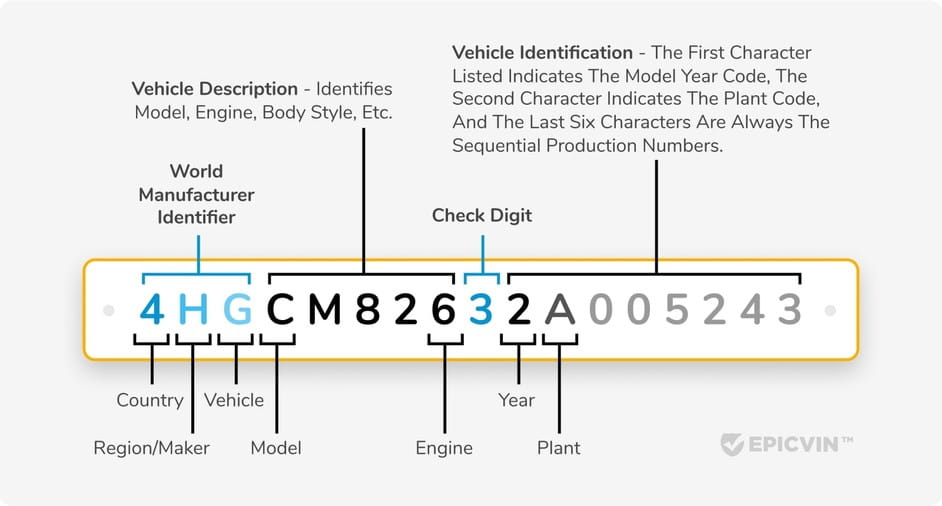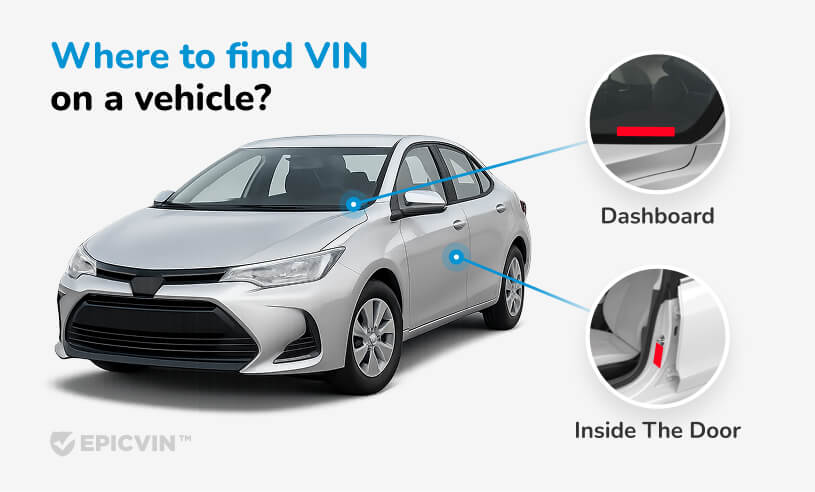
How to Read a VIN Number Like a Pro
From understanding the VIN number breakdown to uncovering a vehicle’s history,...

Instantly decode any BMW VIN to reveal specs, plant options, accident history, recalls, and more — no sign-up required.
Looking for the VIN?
Here is there you’ll find it:

Please check your VIN and try again.
Checking your BMW’s VIN helps reveal the car’s complete history and specs:
A BMW vehicle identification number (VIN) is a unique 17-character code. It's assigned to every BMW vehicle. This standardized identifier follows the international ISO 3779 standard. It contains crucial information about your car's origin, specs, and identity.
The BMW VIN structure typically includes:


After decoding your BMW VIN, you’ll see essential information about your vehicle, including model details, engine specifications, and plant equipment. This free overview provides the most critical data points about your BMW at a glance.
Year 2023
Make BMW
Model X6
Fuel Type Gasoline
Engine 3L
Made in USA
Our free BMW VIN decoder provides crucial vehicle identification data that helps you understand the basic specifications of any BMW. While the free tool reveals the assembler details, engine type, model year, and production line information, the full report delivers a comprehensive BMW history search with access to complete registration records and maintenance documentation. This detailed comparison shows what each option offers to help identify your BMW's complete story.
| Information/Features | Free VIN Decoder | Vehicle History Report |
|---|---|---|
| Factory specs (year, model, engine, transmission) | ✓ | ✓ |
| Active safety recalls | ✓ (total number of records) | ✓ (with details and NHTSA links) |
| Accident/damage records | ✓ (general indicator) | ✓ (Chronology of accidents and insurance cases, including dates and descriptions of damages) |
| Odometer readings/mileage verification | ✓ (latest reading) | ✓ (complete odometer history) |
| Auction photographs and documentation | ✕ | ✓ (when available) |
| Build sheet/options list | ✕ | ✓ (complete) |
| Previous owner count | ✕ | ✓ (full ownership timeline) |
| Theft, lien, or restriction checks | ✕ | ✓ |
| Title status (salvage, rebuilt, flood, etc.) | ✕ | ✓ |
| Sales history | ✕ | ✓ |
| Market value, residual price forecast | ✕ | ✓ |
| Downloadable PDF report | ✕ | ✓ |
| Cost | $0 | Starts from $1 / report |
Check the BMW VIN and make sure your BMW has no hidden issues before you buy. Upgrade to our full report for just $1 to access critical details about past accidents, verify odometer readings, and check for title issues that could affect your vehicle's value. Our detailed analysis uncovers any BMW VIN and reveals everything about your potential purchase.
Based on an internal analysis of 100,000 BMW VIN records in EpicVIN’s database and an estimated fleet of around 6 million BMW vehicles on U.S. roads, we’ve extrapolated how common different risk factors really are.
In EpicVIN’s dataset, the BMW 3 Series family and X5 dominate the salvage rankings. When we project the model mix of our sample onto the estimated U.S. salvage pool (about 700,000 BMW vehicles), we get the following picture:
Here’s what our clients say about the BMW VIN check on EpicVIN:
RRicardoSuper helpful, it was exactly what I was looking for, the complete report of a vehicle I’m planning to buy.
HHector Leon Ibiasgreat because I saw the car involved on an… great because I saw the car involved on an accident, so it puts me off the purchase.
MMahmoudVery comprehensive report generated for the car i looked up.
You cannot decode a BMW made before 1981 if its VIN is shorter than 17 characters. The decoder tool is designed for the standardized 17-character VIN format.
Yes. We use the global BMW WMI prefix database. Therefore, we recognize such BMW VINs as "WBA..." (Germany), "WBX...", "WMW..." (Mini/BMW UK), or "4US..." (USA).
The only difference is in the sources of history: for non-US cars, we cannot pull up US title statuses and insurance damage. However, the technical specifications and build sheet will be accurate. For a complete history of a European car, we recommend adding a paid CARFAX Europe or AutoDNA report - they can be attached to our report.
EpicVIN's free BMW VIN Decoder obtains data from government databases. These include NMVTIS, DMV, DOT, and DPS to decode a vehicle's VIN for the manufacture details.
Looking to upgrade or replace parts for your BMW unit? Check out the BMW online services, such as https://shop.bmwusa.com/, for great options. Just enter your BMW VIN to find compatible electronics, performance enhancements, and interior and exterior accessories.
Yes, the VIN decoder can be used for BMW motorcycles and scooters, as long as the VIN is 17 characters long and follows the standard format.
Yes, you can use the VIN scanner icon on the right side of the input field when using a mobile device, or switch to the "Search by US License Plate" mode.
Discover expert tips, news and advice on buying and maintaining used vehicles

From understanding the VIN number breakdown to uncovering a vehicle’s history,...

Here we'll perform you with a guide on how to check a motorcycle's VIN for fre...

Learn the significance, structure, and typical locations of your mobile home's...